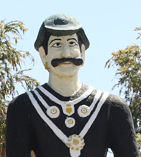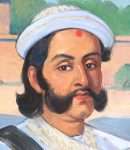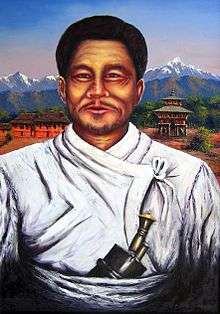Thapa
Thapa (Nepali: थापा; pronunciation:[t̪ʰapa]) is the surname commonly used by Nepali people belonging to the Chhetri caste of Khas group, an Indo-Aryan ethno-linguistic group and Magar people, a Sino-Tibetan ethno-linguistic group.[2][3]
 | |
| Pronunciation | [t̪ʰāpā] |
|---|---|
| Language(s) | Nepali, Doteli, Magar, Kumaoni |
| Origin | |
| Language(s) | Khas language, Magar language |
| Word/name | Khas Kingdom[1] (modern day Karnali, Nepal) |
| Meaning | Warrior[1] |
| Other names | |
| Derivative(s) | Thapa Kaji, Thapa Magar, Thapa Kshetri/Chhetri, Bagale Thapa |
| See also | Basnet, Pande, Rana, Karki, Khadka |
Etymology
Thapa was a Paikelā (warrior) rank of the medieval Khasa kingdom. Other Paikelās include Khaḍgās, Rānās and Buḍhās.[1]:89 It is proved through many inscriptions in the present day region of Old Khas Kingdom. Yasu Thapa, Dasu Thapa and Raj Thapa were known warriors from the herostone pillars.[1]:90 One of the herostone inscription of Thapa warrior:
Be it auspicious. Yasu Thāpā, son of Bhimadev, established the herostone in 1256 Śaka Era.... Be it auspicious. Dhāmu Khaḍgā, son of Bhimadev established the herostone in 1256 Śaka Era...[1]:89
The above inscription also proved that Thapa and Khadka (Khadga) were mere military ranks that was born by sons of same father in the country of Khas people.
Khas Kshatri Thapa
Khas Thapa are patrilineal groups descended from Khas people. They are popularly known as Thapa Kshetri or Thapa Kaji. This group was divided into many clans like Bagale Thapa, Godar, Deoja, Thakuryal,[4] Punwar (Pawar), Su(n)yal, Khulal, Maharaji, Parajuli, Ghimire, Gagliya, Palami, Poudel, Khapatari[5] Lamichhane, Kalikote, Sonal, Bhandare, Achhami, Patkheti, Gaunle and others.[6]
Kshatriya Thapa dynasty were one of the four noble family to be involved in active politics of Nepal together with Shah dynasty, Basnyat/Basnets and Pandes before rise of Rana dynasty.[7] and ruled between 1806 and 1837 and 1843 to 1845.[8] Thapas played important role in Unification of Nepal and had held many prestigious post in the Malla Court and Bijayapur Court.[2] This family grew prominent during the rule of King Prithvi Narayan Shah and were established as dominant faction during reign of King Rana Bahadur Shah.[9] After the assassination of King Rana Bahadur Shah, Bhimsen Thapa rose to the event killing all his enemies and catapulting the Thapa family as most dominant faction in the Royal Court of Nepal.[10]
.jpg)
Thapa family were strengthened in the Royal court by including family members of the another Thapa Bharadar Amar Singh Thapa.[11] Bada (Elder) Kaji Amar Singh Thapa was a legendary military commander and National Hero of Nepal.[12][13] Thapas have important role in Anglo-Nepalese War where Colonial Power British India Company had major loss at First Campaign.[12] Colonel Ujir Singh Thapa was sector commander at Jitgadh, Kaji Ranajor Singh Thapa at Jaithak, Sardar Bhakti Thapa at Deuthal, Colonel Ranabir Singh Thapa at Makawanpurgadhi and Bada Kaji (Elder Kaji) Amar Singh Thapa at Malaon.[12] Bhimsen's nephew PM Mathabarsingh Thapa was known for his charisma from whom Jung Bahadur Rana rose to power. Thus, the state of administrative Thapa rule in Nepal is politically termed as Thapadom.[14]
Bagale Thapa

Bagale Thapa (Nepali:बगाले थापा) is a prominent clan within Khas Thapa.[15] Bagale Thapas were skillful at both warfare and administration.[16] They claim Aatreya Gotra in the Gotra system of Hinduism.[17][18]
Bagale Thapa Vamsāwali (genealogy) part republished by Yogi Naraharinath[19]
The genealogy traces the lineage of all Bagale Thapas to male progenitor (Mūlapuruṣa) King Kalu Thapa Kshatri, who first ascended to the throne at Kāndāmālikā on Saka Era 1111.[19] The DDC of Myagdi district also confirms historical evidence of rule of Thapa dynasty of Takam State (1246-1545 B.S.) by founder Kalu Thapa, whose dynasty continued for 300 years only to be defeated by Dimba Bam Malla to form bigger Parbat State.[20]
Amar Singh Thapa, the war hero of Anglo-Nepalese war belongs to this clan.[17] Similarly, Prime Minister Bhimsen Thapa, the most revered among Thapas also belongs to this clan. His nephew Mathabarsingh Thapa was the seventh Prime Minister of Nepal.[15][21]
Punwar/ Panwar Thapa
Punwar Thapa (Nepali: पुँवर थापा) is another clan of Thapa Chhetri. Punwar/ Panwar, a variant of Parmara dynasty, is a Rajput honorific claimed by different groups.[22] Punwar Thapas claim their ancestry from Rajasthan, India. Sardar Bhakti Thapa a war commander at Anglo-Nepalese war, belonged to the Punwar Thapa clan.[23]
Godar Thapa
Godar Thapa is a clan within Chhetri Thapa of Khas origin.[15] They claim Kashyap Gotra.[18][5]
Parajuli Thapa
Parajuli Thapas were mentioned in the legend of Kunwar family.[24] They were residents of the Dhuage Sanghu village in Kaski.[24] They waged a war against the King of Kaski who wanted the daughter of a nobleman Ahirama Kunwar without legal marriage (as a concubine).[24] Ahirama Kunwar denied the request of the King and Parajuli Thapas successfully protected and helped Ahirama Kunwar to escape to Gorkha Kingdom with his two other sons, one being the later Gorkhali warlord Ram Krishna Kunwar.[24]
Magar Thapa

The original home of the Magar people was to the west of Gandaki river, and roughly speaking, consisted of that portion of Nepal which lies between and around about Gulmi, Argha, Khanchi, and Palpa.[25] This bit of country was divided into twelve districts known as Barha Magarat (Confederation of Twelve Magar Kingdoms) which included Satung, Pyung, Bhirkot, Dhor, Garhung, Rising, Ghiring, Gulmi, Argha, Khanchi, Musikot, Isma. During the medieval period, the whole area from Palpa to Gorkha was called the Magarat as the area was inhabited by Magars. A second Confederation of Eighteen Magar Kingdoms known as Athara Magarat also existed which was primarily inhabited by Kham Magars.[25] Later on, Nepal was divided into different principalities (22 and 24 rajyas: chaubisi in barha Magarat region, baisya ni athara Magarat region). Magars who were the kings and rulers in mid-western and western regions (12th and 18th magarat regions), their estates were eventually invaded by the Shah dynasty and annexed to a single Nepal.
Thapa is one of the six tribes (clans) of the Magar community (one of the core fighting forces of Gorkhali soldiers). In former days, any Thapa (Magar) who had lost three generations of ancestors in battle became a Rana (Magar), but with the prefix of his Thapa clan. Thus, a Reshmi Thapa (Magar) would become a Reshmi Rana (Magar).[25] To name a few—other Thapa Magar clans include Saru, Gaha, Bagalia, Darlami, and they are each further sub-divided into many sub-clans.
Magars from aristocrat families, most commonly Rana and Thapa, were also referred to as Kaji. As per the survey of men who became Kaji in the years 1768-1814, at least 10 were Magars. [26]
Famous Thapa Magars include Arun Thapa, Lakhan Thapa Magar, Biraj Thapa Magar, Victoria Cross holders like Kulbir Thapa, Lalbahadur Thapa and Netrabahadur Thapa.
Links with Indian Royals
Thapas have marital links with Maratha Chhattari royals of Baroda State. Pyar Jung Thapa's daughter, Pragya Shree was married to former King of Baroda State Pratap Singh Rao Gaekwad's grandson Pratapsinh Sangramsinh Gaekwad.[27][28]
Modern times
Modern day Thapas are prominent in wide professions. Manjushree Thapa, an English language author is known for Forget Kathmandu: An Elegy for Democracy (2005), was shortlisted for the Lettre Ulysses Award in 2006.[29] Gagan Thapa, a popular 40-year-old minister is in the Nepalese cabinet.[30] Ujwal Thapa, the President of Bibeksheel Nepali is a leading youth activist and entrepreneur.[31]
Notable people with the surname Thapa
References
- Adhikary, Surya Mani (1997). The Khasa Kingdom: A trans-Himalayan empire of the middle age. Nirala Publications. p. 210. ISBN 8185693501.
- Pradhan 2012, p. 21.
- Bista, Dor Bahadur (1980). People of Nepal (4th ed.). Ratna Pustak Bhandar. pp. 2–4.
- Pradhan 2012, p. 22.
- Nepal Antiquary, Issue 5. Office of the NepalAntiquary. 1978.
- "Chhetri Thapa clans". Retrieved 2017-03-24.
- Joshi & Rose 1966, p. 23.
- Joshi & Rose 1966, p. 25.
- Pradhan 2012, p. 21-22.
- Pradhan 2012, p. 16.
- Pradhan 2012, p. 26.
- http://nepalarmy.mil.np/history.php?page=two
- "National heroes of Nepal". 2011-12-23. Retrieved 2017-03-24.
- Manjushree Thapa. "THAPADOM:The day of Thapa has returned". Retrieved 2017-03-24.
- Pradhan 2012, p. 22.
- Regmi 1978, p. 28.
- Hamal 1995, p. 191.
- "Nepali surnames, clans and gotra". Retrieved 2017-03-24.
- Naraharinath, Yogi (1955). Itihas Prakash. 1. Kathmandu: Itihas Prakash Mandal.
- "Brief Introduction : म्याग्दी जि.स.स". ddcmyagdi.gov.np. Retrieved 24 April 2018.
- "Thapa Personalities". Retrieved 2017-03-24.
- A. Aiyappan; L. K. Bala Ratnam (1956). Society in India. Social Sciences Association. p. 41. Retrieved 21 December 2012.
- "Plea to declare Bhakti Thapa a martyr - The Himalayan Times". thehimalayantimes.com. 31 January 2004. Retrieved 24 April 2018.
- Wright 1877, p. 286.
- Journal of the Asiatic Society of Bengal. Bishop's College Press. 1895.
- Thapa, Deepak; Sijapati, Bandita (2004). A kingdom under siege: Nepal's Maoist insurgency, 1996 to 2003. The Printhouse. ISBN 978-1-84277-570-7.
- "Mumbai's most eligible bachelor Pratap Gaekwad to wed in Nepal - Latest News & Updates at Daily News & Analysis". dnaindia.com. 19 April 2006. Retrieved 24 April 2018.
- "Princess of Baroda Receives the Asia's Royal Woman of the Year at the 3rd G.O.D. Awards at the UN". G.O.D. AWARDS. Retrieved 24 April 2018.
- "Forget Kathmandu: An Elegy for Democracy". Open Democracy.
- "INTERVIEW - Partnership with academic institutions is the key: Health Minister Gagan Thapa". thehimalayantimes.com. 6 April 2017. Retrieved 24 April 2018.
- "Youths stage symbolic protest against 601 MPs (photo feature)". ekantipur.com. Retrieved 24 April 2018.
Sources
- Pradhan, Kumar L. (2012), Thapa Politics in Nepal: With Special Reference to Bhim Sen Thapa, 1806–1839, New Delhi: Concept Publishing Company, p. 278, ISBN 9788180698132
- Hamal, Lakshman B. (1995), Military history of Nepal, Sharda Pustak Mandir
- Regmi, Mahesh Chandra (1978), Regmi Research Series
- Joshi, Bhuwan Lal; Rose, Leo E. (1966), Democratic Innovations in Nepal: A Case Study of Political Acculturation, University of California Press, p. 551